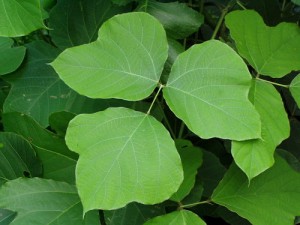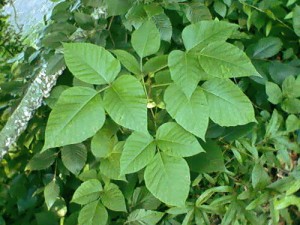I spoke with one of the senior locals in my area who said that she had cooked kudzu by breading it and frying it… similar to those who eat squash blossoms. I think that breading is more like disguising something that either doesn’t taste good, or just doesn’t taste otherwise. Kudzu, like other greens can taste bitter or grassy like something a cow WOULD eat. However, I’ve discovered that the lighter green leaves at the ends of the vine are less robust. If they were boiled, you can pour out the first round of water and boil it a second time. However, I’ve tried sauteing the leaves in olive oil with some salt and pepper and was delighted with the results… a civil taste.
Like string beans, kudzu veins can be tough, so when preparing the leaves for cooking, hold on to the body of the leaf in one hand and the stem with the other hand and pull out the veins that are tough. And like spinach, kudzu cooks down from a large pile into a smaller mass. I’ve included two photos… one of poison ivy, and one of kudzu, to differentiate the two for identification purposes. Although they are arranged in “leaves of three” the poison ivy tends to be a smooth teardrop shape whereas the kudzu has significant lobes on both sides of the end leaf and a significant lobe on one side of each of the secondary leaves. Kudzu leaves tend to be significantly larger as well.
If Kudzu seems an odd thing to eat, just remember that in parts of Germany people still consider corn to be pig food… so don’t let local culture discourage you from discovering this edible food.






Don’t forget the root. It is a great source of starch and is used as a thickener for soups and stews in Japan. It’s sold in grocery stores in Japan and at Whole Foods in the Macrobiotic section.
Pingback: Cooking kudzu | Justmetel